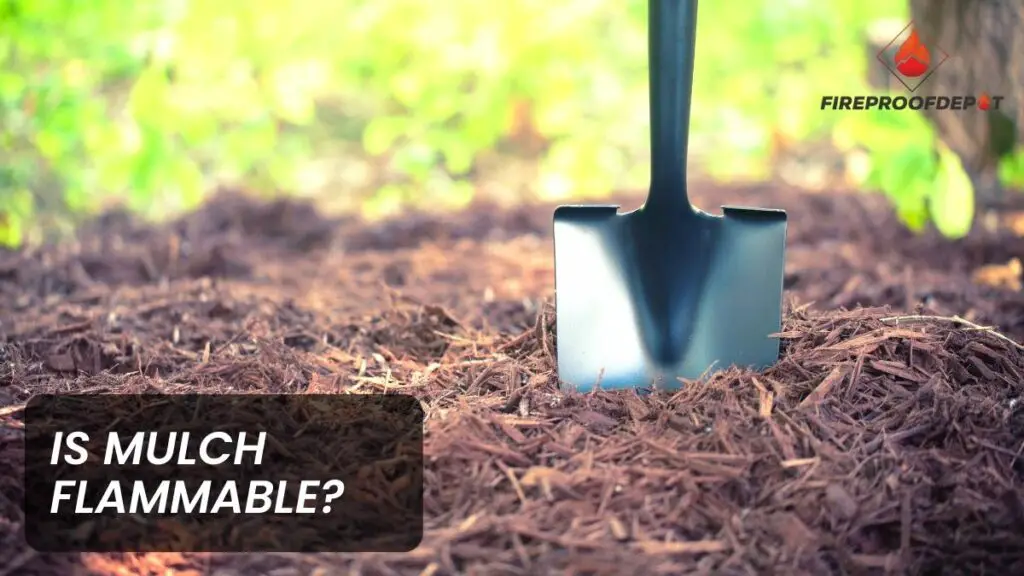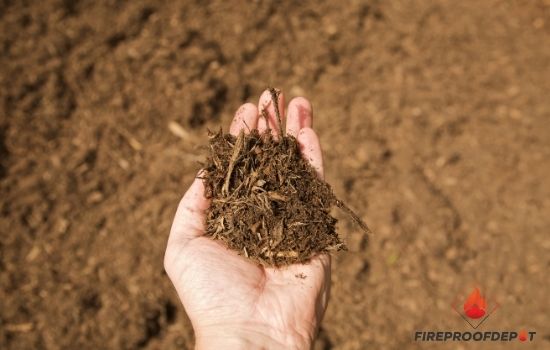Yes, organic mulch is flammable under certain conditions. When mulch is dry and the moisture in the air is critically low, it can easily catch fire if exposed to a spark or flame. High temperature, lack of rain, and strong wind are some factors that play key roles in catching fire from a large mulch pile.
However, inorganic mulch that’s composed of rocks, gravel, or granite isn’t flammable as these materials have a solid internal structure. If you’re using organic mulch, it’s important to follow proper safety precautions.
You must keep it moist, place it far from heat sources, and avoid smoking near it. Let’s get into the details and find out the flammability of different types of mulch.

Which Mulch Is Most Flammable?
All types of organic mulch are flammable. This type of mulch is typically made up of organic matter such as leaves, twigs, bark, and wood chips. Organic mulch is mostly used to cover the soil in gardens and landscaping.
As the materials are collected from plants, all of them contain carbon which makes them highly flammable. However, some mulch is less risky than others depending on the used materials.
Below is the flammability of different types of organic mulch based on the observations of the National Fire Protection Association or NFPA.
- Pine needles, shredded rubber and western red cedar are the most flammable mulch materials. The rubber compound burns the hottest (over 630°F at 4 inches height) and produces the highest flame at over 3ft.
- Composted wood chips are the safest mulch material as they spread slowly. The produced flame also doesn’t rise much high. Only the smoldering lasts for a long time.
- Shredded western red cedar mulch spreads the fastest, traveling 47.9 feet per minute on average. It also produces embers that ignite adjacent mulch plots.
What Mulch Is Least Flammable?
As mentioned, inorganic mulch is made of brick chips, pebbles, shells, rocks, and gravel. This type of mulch is fire-resistant and doesn’t burn even at high temperatures.
All the materials used in inorganic mulch are solid and don’t contain flammable hydrocarbon chains. The atomic bonds of these materials are so strong that heat can’t separate the molecules and turn them into flammable gases.

Besides, such mulches are heavy, so they don’t get scattered by a strong wind which often spreads bushfires. Therefore, inorganic mulch is the least flammable and completely safe to use in landscapes.
How Do You Extinguish a Mulch Fire? – Step-by-Step Water Hose Method Explained!
If you notice a mulch fire, the first thing you need to do is call the fire department. Handling it on your own can be life-threatening since mulch fires spread at very fast rates to a large area. So, only experts can control them.
Meanwhile, until the professionals arrive, you can try to put out the fire with water and wet blankets; whatever you have at hand. Follow the steps given below to put out a mulch fire.
Method 1: Use a Hose or Pipe to Spray Water
- Try to find a pressurized water system for continuous supply.
- Connect hoses to the water source and start by extinguishing the minor fires.
- Remove or wet potential fuel from the area surrounding the fire.
Method 2: In Case of No Access to a Hose/Pipe for Water Supply, Try Water Filled Bucket
- If no hoses are available nearby, use buckets, pots, or other large containers to fill water and throw them at the blaze from a safe distance.
- Wet the ground following the route of the fire so that it can’t spread easily.
Method 3: If There’s No Bucket, Then Try Wet Blanket
- Dip a blanket in the water and place it over the burning mulch.
- Wait until the fire is extinguished and there’s only smoke left.
- Repeat the process to cover all the minor blazes.
Method 4: Create a Fire Break
In case there are no water sources nearby, you need to create a fire break. Use heavier equipment such as a bulldozer to quickly dig a trench around the whole perimeter of the fire.
This way, the blaze can’t spread further unless there’s a very strong wind. You can use handheld tools too, but they will take time.
Preventing Mulch Piles from Catching Fire
Thankfully, mulch fires can be prevented just by taking some easy measures. You have to make sure there are no fire sources around the mulch. It’s also important to keep the mulch wet.
Here’s how you can easily prevent a mulch fire −
Monitor Mulch Pile Temperature
Regularly monitoring your mulch piles is the best way to protect them from combustion. Dry mulch piles gather high heat and smoke starts to form as the temperature rises.
Upon coming in contact with an open flame, the smoke turns into fire and spreads immediately.

So, you need to check the temperature of the mulch pile with a temperature gun. If the reading exceeds 155-185°F, break the pile and make it wet to release the heat.
Create Mulches in Safe Locations
If there’s a fire source near the mulch, it’s a potential fire hazard. Don’t plant any heat sources or spark plugs near mulch piles.
Provide at least 30 feet of clearance between your house and the mulch piles. In case you’re planting multiple mulches, be sure to maintain a 5 feet distance between two piles.
Water the Mulch Piles
Lack of moisture is the key reason why mulch piles catch fire. If your mulch piles have been seasoned for 6 months or more, there’s a high chance these piles are dry and hot.
So, you must water your old mulch pile regularly, especially if it’s made of pine needles or shredded red cedar.
Don’t Make High Mulch Piles
High mulch piles hold more heat which paves the way for creating hot steams. It will help the organic materials to ignite more easily.
Try to make thin mulch layers; 2 to 4 inches thick piles are preferable. Don’t make the mulch piles higher than 6 inches if you want to prevent them from catching fire.
Frequently Asked Questions
1. How does mulch generate heat?
Mulch contains organic materials that absorb the heat coming from the sun. Besides, the soil bacteria decompose the organic materials and release energy in the form of heat. This way, mulch piles keep generating heat.
2. How hot does wood mulch get?
If built correctly, wood mulch can easily generate up to 141°F to 155°F only within 24-36 hours. The temperature will remain constant for weeks and start rising further if the environment remains hot and dry.
3. Is mulch safe to breathe?
No, you must not breathe mulch as it contains harmful bacteria. Inhaling organic mulch increases the chances of breathing in Legionella bacteria. Besides, older mulches might produce toxic gases like methane or carbon monoxide.
Wrapping Up!
So, is mulch flammable? There you have the answer. Organic mulch is highly combustible given the right environmental conditions. In hot and dry weather conditions, mulch can dry out quickly, which increases its flammability.
Also, if the mulch is located near heat sources or ignition sources like cigarettes, grills, or other open flames, it can become a fire hazard. So, you must keep a safe distance between mulch and populated structures to reduce the risk of fire spreading.
